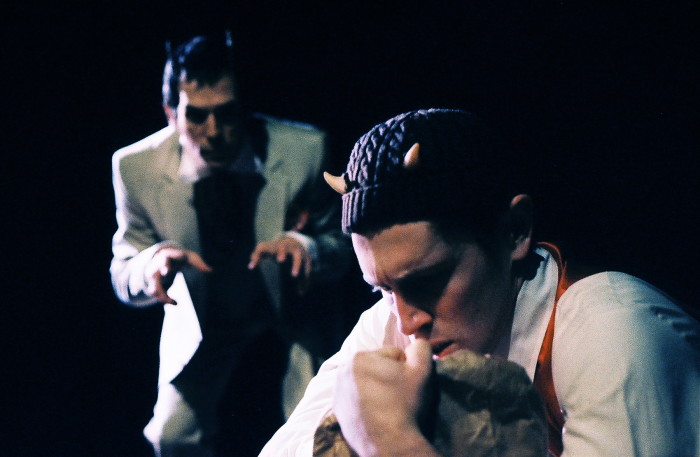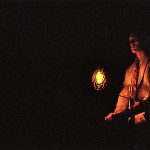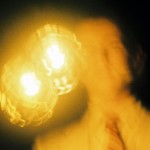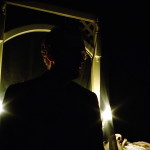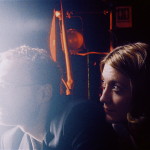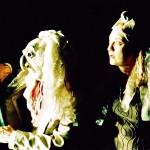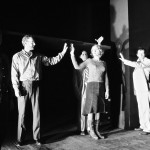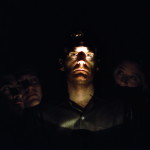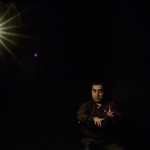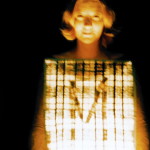Photos by The Hinge Collective
Excerpts from the reviews
“An extraordinarily creepy meditation on fear, Apparition, will raise hairs on the back of your neck. The actors portray demons as transient petty crooks (with horns, mind you) who hide in piles of leaves or break into people’s basements, slaking their infernal appetites on house pets. But when Smith tells Blumenthal that he might, just might, have a human baby in the bag, the second demon balks, faced with an unexpected moral dilemma. The scream that punctuates the scene could be your own. . . . Washburn’s well-tuned ear for minute details and mounting panic leads to sensational scenarios.” David Cote, Time Out NY
“Director Linsay Furman has assembled at Chashama a cast that would knock the cufflinks off most Broadway actors. The five performers are identified by letters, not names, and sometimes can’t be discerned in the low, gloomy light.When you can’t quite see T. Ryder Smith, you’re more likely to notice the range and subtlety of his vocal effects. He brings a tone of almost Gothic formality to the eerie proceedings. As usual, Steven Rattazzi is the funniest person onstage; he’s also responsible for the evening’s most unnerving scene, a monologue about whispers in his darkened apartment. Heidi Schreck’s light, clear voice adds an unsettling upper register to the show. . . . Spooky fun.” Jeremy McCarter, NY Sun
“Here, in an unheated theater with uncomfortable chairs, playwright Anne Washburn unveils a heavy-booted maniac, a backyard demon, a vanished spirit (whiskey, with soda), a forest full of weevils, and the fearsome Dark Morton. Apparition: An Uneasy Play of the Underknown toys with genre, borrowing from the thriller, the sci-fi story, the campfire screecher—even, liberally, from Macbeth. Under Linsay Firman’s direction, five actors perform these tales in the ashen whites and sickly golds of Matt Frey’s lighting. With hardly any props or set, the cast manages to summon up full worlds—each with particular rules and characteristics—within a few sentences. . . .” Alexis Soloski, Village Voice
Offstage
Above, standing: Heidi Schreck, David Brooks, Scott Blumenthal, Andrea J. Berkey, Steve Ratazzi, T. Ryder Smith. Sitting: director Linsay Firman, playwright Anne Washburn, unknown.
Full reviews
Time Out NY, David Cote -Under normal circumstances, a brown paper bag should not inspire terror. Yet the one offered by T. Ryder Smith to Scott Blumenthal in Anne Washburn’s extraordinarily creepy meditation on fear, Apparition, will raise hairs on the back of your neck. The actors portray demons as transient petty crooks (with horns, mind you) who hide in piles of leaves or break into people’s basements, slaking their infernal appetites on house pets. But when Smith tells Blumenthal that he might, just might, have a human baby in the bag, the second demon balks, faced with an unexpected moral dilemma. The scream that punctuates the scene could be your own. Apparition (subtitled An Uneasy Play of the Underknown) is a loose collection of sketches and monologues by five actors, linked by choral scenes that summarize the plot of Macbeth. The group sequences are less effective than the individual ones, in which Washburn’s well-tuned ear for minute details and mounting panic leads to sensational scenarios. Steven Rattazzi, a wry everyman, delivers a chilling tale about his first night in a new apartment. Each time he tries to call a friend, he hears a strange, incoherent whispering on the other end. When the lights go out and someone starts pounding on his door, you’re ready to bolt from the theater. Speaking on a microphone in near total darkness, Heidi Schreck plays a woman who has been accidentally slashed by her boyfriend and who matter-of-factly describes her life draining away. Director Linsay Firman stages it all with simplicity and wit on a bare set, queasily lit at times by fluorescent bulbs. Such is the canniness of the director, writer and cast that the flat, institutional lighting can illuminate the darker precincts of the human psyche.11-03
The Village Voice, Alexis Soloski – Darkness Risible, Wicked wordsmith Anne Washburn rouses campfire chills. Deserted woods, remote make-out spots, creaky mansions—these are ghost story locales. The stretch of West 42nd between Sixth and Seventh is not. With Condé Nast headquarters at one end and Tad’s broiled steaks at another, it appears at once too corporate slick and too cut-rate smarmy to allow for the otherworldly. But here, in an unheated theater with uncomfortable chairs, playwright Anne Washburn unveils a heavy-booted maniac, a backyard demon, a vanished spirit (whiskey, with soda), a forest full of weevils, and the fearsome Dark Morton. Apparition: An Uneasy Play of the Underknown toys with genre, borrowing from the thriller, the sci-fi story, the campfire screecher—even, liberally, from Macbeth. Under Linsay Firman’s direction, five actors perform these tales in the ashen whites and sickly golds of Matt Frey’s lighting. With hardly any props or set, the cast manages to summon up full worlds—each with particular rules and characteristics—within a few sentences. When a woman (Heidi Schreck) wakes a man (David Brooks) in his attic bedroom, she murmurs that she might be a ghost or possibly a succubus. “Oh, no you’re not,” he explains matter-of-factly. “If you were a demon . . . I’d feel a terrible sense of oppression. And I would feel the presence of another presence in the room, because demons are always more than their human containers.” Similarly, Washburn’s script is more than the sum of its words—though those words are lovely, especially “reticulating.” Her situations are ineluctably theatrical. This is not a text secretly wishing it were a novel or teleplay. Her writing considers the mystery of human presence; it requires live performance. Though witches and spooks may be immediate characters, her larger subject concerns how much we can ever know of this world or any other. In her hands, even an ordinary bus trip seem inscrutable. A demon (T. Ryder Smith) explains, “They’re easy to get into, once they are there, but you have to know where they will appear. I have a bus schedule, obtained with great difficulty; there is a map, which shows everywhere the bus goes, and most importantly, it shows the space you must stand on, to stop it.” Occasionally the play devolves into silliness (bouts of fake Latin) or veers too far into non sequitur. Perhaps the end gutters out when it ought to be abruptly snuffed. But when, just before the curtain, a character intones, “The light is off and the dark is still on,” you find yourself wishing that Washburn’s dark would indeed go on, at least for a little while longer. 11.18.03
New York Sun, Jeremy McCarter – Anne Washburn’s new play “Apparition” takes the prize for most intriguing subtitle of the year: “An Uneasy Play of the Underknown.” It is a compendium of obscure scenes involving ghosts, demons, and “the play which must not be named”: “Macbeth.” Director Linsay Furman has assembled at Chashama a cast that would knock the cufflinks off most Broadway actors. The five performers are identified by letters, not names, and sometimes can’t be discerned in the low, gloomy light.When you can’t quite see T. Ryder Smith, you’re more likely to notice the range and subtlety of his vocal effects. He brings a tone of almost Gothic formality to the eerie proceedings. As usual, Steven Rattazzi is the funniest person onstage; he’s also responsible for the evening’s most unnerving scene, a monologue about whispers in his darkened apartment. Heidi Schreck’s light, clear voice adds an unsettling upper register to the show. Ms.Washburn has a playful theatrical intelligence, one that refuses to be pinned down. This leads to a distended feeling in the script, a sense that she leads us around the track once (thematically speaking), and starts on lap two before saying goodnight. Don’t get caught up in overanalyzing this elliptical play — it will spoil the spooky fun. Better to listen, absorb, and quail. 11-18-03
Off-Off Broadway Review, Brittney Jensen– The star of ‘Apparition’ was lighting designer Matt Frey, assisted by Scott Bolman. His use of light and copious darkness combined with Erik Flatmo’s sparse but evocative set and Shane Rettig’s eerie sound to create a genuinely spooky atmosphere for this play about witches, demons, and other frightening entities. The play opened with five actors scattered on stage, each lit with a single ghostly light he or she held, like the old slumber-party flashlight-on-the-face trick, but much more effective. As the actors muttered disparate fragments of scary stories, the audience waited for the play to start. They waited for the spoken flotsam to come together and make sense. But neither hoped-for event happened. Random scenes and nonsensical interludes shaped 75 minutes of mostly pretentious tedium only partially relieved by the thick atmosphere, strong production values, and occasional flashes of intriguing dialog. The segments, loosely connected in their ghastly themes, include two demons discussing dinner, a lengthy retelling of Macbeth, and a woman chanting fake Latin with candles. The narrative scenes were generally more engaging than the interludes where the actors interrupted each other’s non-linear declaiming to the audience. The most interesting moments were when a single actor described, in the first person, a terrifying moment involving mysterious creeping attackers. At least for a few minutes, the writing didn’t force the audience to unsuccessfully strain to piece together what was going on; instead the play just frightened and, more importantly, entertained. The ensemble cast, which included Steve Rattazzi, David Brooks, T. Ryder Smith, Scott Blumenthal, and Heidi Schreck, was exceptionally strong in the narrative scenes, and did their best with the disconnected orations. Schreck had an especially moving monolog as a woman in a dark attic who may be bleeding to death. Directed by Linsay Firman, the acting was vigorous but believable, although the actors couldn’t quite make Washburn’s halting speech, with frequent mid-sentence interruptions, sound natural. Overall, the production was smooth and polished, thanks to a large crew that included master carpenter Joe Cairo, electricians Mark Simmons and James Patrick Ging, and sound operator Kenneth Armour. The costumes of designer Sarah Beers and her assistants Merav Elbaz and Hannah Bassett were simple but effective. In one scene two men were transformed into demons with minimal but telling accessories. Witch masks designed by Manju Shandler were appropriately grotesque. During the play, an unidentified character says that once he woke up to see a demon in his room. He can’t remember exactly what the demon said to him; he describes it as meaningless small talk, like conversations you overhear on a bus. Unfortunately this description applies to too many moments in the script of this otherwise promising production. 11-03
[previous] [next]
